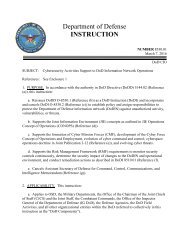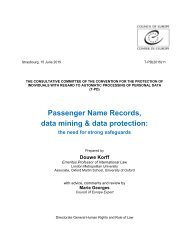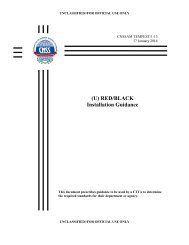data-breaches-in-europe
data-breaches-in-europe
data-breaches-in-europe
Create successful ePaper yourself
Turn your PDF publications into a flip-book with our unique Google optimized e-Paper software.
Data Breaches <strong>in</strong> Europe:<br />
Reported Breaches of Compromised Personal Records <strong>in</strong> Europe, 2005‐2014<br />
Philip N. Howard<br />
CMDS Work<strong>in</strong>g Paper 2014.1<br />
Center for Media, Data and Society<br />
School of Public Policy<br />
Central European University<br />
October, 2014
Table of Contents<br />
I. Executive Summary ............................................................................................................... 3<br />
II. Reports of Data Breaches <strong>in</strong> Europe ..................................................................................... 4<br />
1. Introduction ...................................................................................................................... 4<br />
2. Methodology ..................................................................................................................... 4<br />
3. F<strong>in</strong>d<strong>in</strong>gs: Descriptive Statistics .......................................................................................... 6<br />
4. F<strong>in</strong>d<strong>in</strong>gs: Europe‐wide Comparisons ............................................................................... 10<br />
5. F<strong>in</strong>d<strong>in</strong>gs: Unusual Country Cases .................................................................................... 12<br />
III. About the Project ............................................................................................................ 17<br />
1. Correspondence .............................................................................................................. 17<br />
2. About the Authors ........................................................................................................... 17<br />
3. Research Team ................................................................................................................ 17<br />
IV. Institutions and Fund<strong>in</strong>g ................................................................................................. 18<br />
1. The Center for Media, Data and Society ......................................................................... 18<br />
2. The School of Public Policy .............................................................................................. 18<br />
3. Central European University ........................................................................................... 18<br />
V. Appendix A: Case and Variable Def<strong>in</strong>itions ......................................................................... 19<br />
VI. Appendix B: Sources ........................................................................................................ 20<br />
VII. Appendix C: Country‐Specific Breaches .......................................................................... 21<br />
Tables<br />
Table 1: Quick Fact Table .............................................................................................................. 7<br />
Table 2: Severity of Breach Patterns, Top 5 Country Targets ....................................................... 9<br />
Table 3: Type of Loss, Three Categories ........................................................................................ 9<br />
Table 4: Type of Loss, Six Categories ........................................................................................... 10<br />
Table 5: Data Breach by Type of Organization Compromised .................................................... 10<br />
Figures<br />
Figure 1: Volume and Number of Breach Incidents, 2005‐2014 ................................................... 8<br />
2
I. Executive Summary<br />
A grow<strong>in</strong>g number of massive <strong>data</strong> <strong>breaches</strong> are degrad<strong>in</strong>g the personal privacy of people<br />
around the world. Data security and privacy policy are ongo<strong>in</strong>g concerns <strong>in</strong> Europe. But it can<br />
be difficult to assess privacy <strong>breaches</strong> <strong>in</strong> Europe <strong>in</strong> particular, s<strong>in</strong>ce many of the biggest<br />
<strong>in</strong>cidents of compromised personal records <strong>in</strong>volve people and organizations from around the<br />
world. This work<strong>in</strong>g paper offers early descriptive statistics and analysis of the first crossnational,<br />
systematized event log of <strong>data</strong> <strong>breaches</strong> <strong>in</strong> Europe. The <strong>data</strong> is available for download<br />
at http://cmds.ceu.hu/.<br />
Methodology. The sample frame <strong>in</strong>cludes major media news reports on compromised<br />
personal records and is unique for:<br />
sampl<strong>in</strong>g 28 European Union member countries, plus Norway and Switzerland;<br />
sampl<strong>in</strong>g from 2005 through the third quarter of 2014;<br />
sampl<strong>in</strong>g credible news sources <strong>in</strong> national languages;<br />
high social science standards for event <strong>data</strong>base construction, with multiple sourc<strong>in</strong>g,<br />
<strong>in</strong>ter‐coder reliability tests, recod<strong>in</strong>g, and specific exclusion criteria.<br />
F<strong>in</strong>d<strong>in</strong>gs. A <strong>data</strong> breach is def<strong>in</strong>ed as any <strong>in</strong>cident <strong>in</strong>volv<strong>in</strong>g the loss or exposure of digital<br />
personal records. Personal records are def<strong>in</strong>ed as a) <strong>data</strong> conta<strong>in</strong><strong>in</strong>g privileged <strong>in</strong>formation<br />
about an <strong>in</strong>dividual that cannot be readily obta<strong>in</strong>ed through other public means and b) this<br />
<strong>in</strong>formation only known by an <strong>in</strong>dividual or by an organization under the terms of a<br />
confidentiality agreement. Prelim<strong>in</strong>ary analysis reveals that over the last decade:<br />
<br />
<br />
<br />
<br />
Some 229 <strong>data</strong> breach <strong>in</strong>cidents <strong>in</strong>volved the personal records of people <strong>in</strong> Europe.<br />
Globally, all these <strong>in</strong>cidents resulted <strong>in</strong> the loss of some 645 million records, though<br />
not all of these <strong>breaches</strong> exclusively <strong>in</strong>volved people <strong>in</strong> Europe. With<strong>in</strong> Europe, we<br />
confirmed 200 cases <strong>in</strong>volv<strong>in</strong>g people <strong>in</strong> Europe, and 227 million records lost <strong>in</strong><br />
Europe‐specific <strong>breaches</strong>.<br />
The total population of the countries covered <strong>in</strong> this study is 524 million, and the total<br />
population of <strong>in</strong>ternet users <strong>in</strong> these countries is 409 million. Expressed <strong>in</strong> ratios, this<br />
means that for every 100 people <strong>in</strong> the study countries, 43 personal records have been<br />
compromised. For every 100 <strong>in</strong>ternet users <strong>in</strong> the study countries, 56 records have<br />
been compromised.<br />
Fully 51 percent of all the <strong>breaches</strong> <strong>in</strong>volved corporations and 89 percent of all the<br />
breached records were from compromised corporations. Among all the k<strong>in</strong>ds of<br />
organizations from which personal records have been compromised, 41 percent of the<br />
<strong>in</strong>cidents <strong>in</strong>volved clear acts of theft by hackers, but 57 percent of the <strong>in</strong>cidents<br />
<strong>in</strong>volved organizational errors, <strong>in</strong>sider abuse, or other <strong>in</strong>ternal mismanagement (2<br />
percent unspecified).<br />
The level of sophistication and detail <strong>in</strong> journalism about issues of privacy and personal<br />
<strong>data</strong> has <strong>in</strong>creased, but is largely driven by national “mandatory report<strong>in</strong>g” rules <strong>in</strong><br />
particular countries. In other words, we know most about <strong>data</strong> leaks <strong>in</strong> countries<br />
where organizations are required to report that personal records have been<br />
compromised.<br />
3
II.<br />
Reports of Data Breaches <strong>in</strong> Europe<br />
1. Introduction<br />
The <strong>in</strong>ternet, mobile phones, and a host of other new <strong>in</strong>formation technologies have allowed<br />
more and more people to conduct the bus<strong>in</strong>ess of their personal lives over digital media. And<br />
even people who are not heavy technology users are tracked, surveilled, and surveyed, mak<strong>in</strong>g<br />
facts about their attitudes, behaviors, and other life details are tracked electronically. Many of<br />
those activities, such as bank<strong>in</strong>g, shopp<strong>in</strong>g, e‐government, social network<strong>in</strong>g, and email<strong>in</strong>g,<br />
require disclosure of a certa<strong>in</strong> degree of personal <strong>data</strong>. The <strong>data</strong> citizens or companies store<br />
onl<strong>in</strong>e ranges from email or postal addresses, log<strong>in</strong> <strong>in</strong>formation or passwords to sensitive<br />
personal <strong>in</strong>formation, <strong>in</strong>clud<strong>in</strong>g bank and credit card account <strong>in</strong>formation. The more activities<br />
take place onl<strong>in</strong>e, the more <strong>data</strong> is stored <strong>in</strong> servers. Such situations pose certa<strong>in</strong> challenges to<br />
ma<strong>in</strong>ta<strong>in</strong><strong>in</strong>g privacy and keep<strong>in</strong>g <strong>data</strong> safe.<br />
Almost everyth<strong>in</strong>g we know about privacy violations <strong>in</strong> Europe comes from news reports on<br />
specific <strong>breaches</strong>. So what can we learn about the big picture assembl<strong>in</strong>g the highest quality<br />
reports—across countries and languages—about compromised personal records?<br />
Privacy policy and <strong>data</strong> protection is a contemporary concern of policymakers <strong>in</strong> Europe.<br />
Countries such as Germany, the United K<strong>in</strong>gdom, and Ireland are implement<strong>in</strong>g strict rules for<br />
<strong>in</strong>formation management and <strong>data</strong> protection. Due to software vulnerability, <strong>data</strong><br />
mismanagement or simple human <strong>in</strong>discretion <strong>data</strong> is stolen or lost quite frequently. There<br />
have been several attempts to measure the costs of such <strong>data</strong> loss. However, there have been<br />
few systematic efforts to measure the scale of <strong>data</strong> <strong>breaches</strong> across Europe. Given that Europe<br />
has unique values when it comes to privacy and surveillance, we seek to provide new<br />
knowledge on the scale and quantity of breached <strong>data</strong>.<br />
Non‐governmental organizations and <strong>data</strong> protection authorities acknowledge that there has<br />
been a steady <strong>in</strong>crease <strong>in</strong> <strong>data</strong> <strong>breaches</strong>. Although Europe is mov<strong>in</strong>g towards the unified policy<br />
of <strong>data</strong> protection and requirements for report<strong>in</strong>g <strong>data</strong> <strong>breaches</strong>, there is a huge lack of<br />
<strong>in</strong>formation about exact cases and <strong>in</strong>cidents. Not only are there few news accounts of big<br />
picture trends <strong>in</strong> <strong>data</strong> <strong>breaches</strong>, but public policy researchers have little comparative <strong>data</strong> to<br />
work with. Several years ago, another comparative event <strong>data</strong>base about <strong>in</strong>cidents of<br />
compromised records <strong>in</strong> the United States revealed that 1.9 billion records were compromised<br />
between 1985 and 2006. In 2006, this meant that for every hundred U.S. adults 875 personal<br />
records had been breached. 1<br />
For us, the lack of organized event records is both an empirical obstacle and an opportunity to<br />
generate new knowledge about <strong>data</strong> and privacy protection. This study <strong>in</strong>vestigates a decade<br />
of records to help assess both the chang<strong>in</strong>g volume and character of <strong>data</strong> <strong>breaches</strong> and the<br />
way <strong>in</strong> which those <strong>breaches</strong> are reported to the public <strong>in</strong> Europe.<br />
2. Methodology<br />
To understand the trends <strong>in</strong> <strong>data</strong> <strong>breaches</strong>, we built an orig<strong>in</strong>al event <strong>data</strong>base of <strong>in</strong>cidents as<br />
reported <strong>in</strong> credible, multil<strong>in</strong>gual news media <strong>in</strong> Europe. The <strong>data</strong>base we built and on which<br />
our f<strong>in</strong>d<strong>in</strong>gs are based <strong>in</strong>cludes all the cases reported on the <strong>in</strong>ternet <strong>in</strong> which personal <strong>data</strong> of<br />
1<br />
Erickson, Kris, and Philip N. Howard. (2007). “A case of mistaken identity? News accounts of hacker,<br />
consumer, and organizational responsibility for compromised digital records.” Journal of Computer‐<br />
Mediated Communication 12(4): 1229‐1247.<br />
4
European citizens—those of the 28 European Union Member States plus Norway and<br />
Switzerland—were compromised dur<strong>in</strong>g the period 2005–2014, <strong>in</strong>clud<strong>in</strong>g <strong>data</strong> <strong>breaches</strong>, leaks,<br />
and identity thefts. 2 Because so few cases were reported prior to 2005, we limit our<br />
comparative event analysis to the <strong>in</strong>cidents coded and catalogued over the last decade.<br />
S<strong>in</strong>ce our study focuses on cases whose victims were European, <strong>in</strong>stances <strong>in</strong> which European<br />
citizens compromised <strong>data</strong> of overseas citizens do not appear <strong>in</strong> our <strong>data</strong>base, even though we<br />
found dozens of such cases. Although they are unquestionably examples of privacy violation,<br />
we also did not <strong>in</strong>clude cases of surveillance, as we were concerned with how already exist<strong>in</strong>g<br />
<strong>data</strong> is handled rather than with how <strong>data</strong> is collected. The <strong>data</strong>base, moreover, excludes<br />
<strong>in</strong>stances <strong>in</strong> which the compromised <strong>data</strong> were not personal <strong>in</strong> nature. Neither were we<br />
concerned with hacker attacks whose direct aim was f<strong>in</strong>ancial ga<strong>in</strong>—for example, those<br />
<strong>in</strong>volv<strong>in</strong>g transferr<strong>in</strong>g money from one bank account to another—and otherwise did not<br />
compromise personal <strong>data</strong>. Incidents <strong>in</strong>volv<strong>in</strong>g phish<strong>in</strong>g or malware were excluded because<br />
their impact was impossible to estimate <strong>in</strong> the overwhelm<strong>in</strong>g majority of cases. We were not<br />
concerned with privacy <strong>breaches</strong> of paper‐based records.<br />
The compromised personal records had to concern citizens of the countries we were study<strong>in</strong>g.<br />
There were four cases of <strong>breaches</strong> on embassies that were excluded from this analysis. These<br />
were the embassies of governments outside Europe that were physically located <strong>in</strong> Europe and<br />
were compromised. But the <strong>data</strong> lost probably <strong>in</strong>volved nationals from outside Europe. If the<br />
news report <strong>in</strong>cluded details about the k<strong>in</strong>ds of documents compromised or the number of<br />
gigabytes of <strong>data</strong> put at risk, the case was coded but then excluded from analysis. Only cases<br />
with personally identifiable <strong>in</strong>formation of people liv<strong>in</strong>g <strong>in</strong> the European Union, Norway and<br />
Switzerland. Given the diversity of report<strong>in</strong>g styles and variations <strong>in</strong> <strong>in</strong>formation completeness,<br />
we implemented the standard rubric for codify<strong>in</strong>g and quantify<strong>in</strong>g news reports. If the news<br />
reported “thousands” then the value 3,000 was recorded, if the news reported “tens of<br />
thousands” then the value 30,000 was recorded. Broad, nonspecific reports of phish<strong>in</strong>g and<br />
malware attacks were excluded. Reports about the compromised personal records of<br />
European Union citizens by the national security agencies of other countries (such as the<br />
United States) were also excluded. Second hand reports and unsourced reports were excluded.<br />
We looked for reports on personal <strong>data</strong> be<strong>in</strong>g compromised on specialized websites and <strong>in</strong> the<br />
LexisNexis Academic and the Google News <strong>data</strong>bases. Appendix A identifies the cod<strong>in</strong>g<br />
variables, and Appendix B identifies the list of specialized websites used <strong>in</strong> the snowball<br />
sampl<strong>in</strong>g strategy. Appendix C presents the country by country breakdown of <strong>in</strong>cidents. We<br />
also utilized the language skills present <strong>in</strong> the project team 3 by search<strong>in</strong>g for relevant terms on<br />
Google and thus found related reports on national specialized and news websites. For the rest<br />
of the countries <strong>in</strong> our sample we did top level doma<strong>in</strong> name searches us<strong>in</strong>g Google Translate.<br />
As much as possible, we relied on credible news reports rather than on user‐generated<br />
content. We did not use sources that conta<strong>in</strong>ed aggregated <strong>data</strong> because of the possibility of<br />
unidentifiable overlaps among them and their different conceptualizations of what constitutes<br />
a <strong>data</strong> breach. We also aimed to f<strong>in</strong>d more than one source for each of the cases. All <strong>in</strong> all, the<br />
2<br />
The countries <strong>in</strong>cluded <strong>in</strong> this case list <strong>in</strong>clude: Austria, Belgium, Bulgaria, Croatia, Cyprus, Czech<br />
Republic, Denmark, Estonia, F<strong>in</strong>land, France, Germany, Greece, Hungary, Ireland, Italy, Latvia, Lithuania,<br />
Luxembourg, Malta, Netherlands, Norway, Poland, Portugal, Romania, Slovakia, Slovenia, Spa<strong>in</strong>,<br />
Sweden, Switzerland, and the United K<strong>in</strong>gdom.<br />
3<br />
The language‐specific searches <strong>in</strong>clude: Bulgarian, Croatian, Czech, Dutch, English, Estonian, F<strong>in</strong>nish,<br />
French, German, Hungarian, Italian, Latvian, Lithuanian, Polish, Slovakian, Slovenian, and Romanian.<br />
5
esearch team of eleven people spent 450 hours identify<strong>in</strong>g and evaluat<strong>in</strong>g <strong>data</strong> breach<br />
reports. As is common with event <strong>data</strong>sets, a standard set of <strong>in</strong>cident descriptors was<br />
collected:<br />
<br />
<br />
<br />
<br />
<br />
<br />
<br />
when it was reported,<br />
when it occurred,<br />
which country and organization was affected by it,<br />
to which sector the affected organization belongs,<br />
how strong its impact was (measured as the total number of people, records,<br />
gigabytes, or emails compromised);<br />
what k<strong>in</strong>d of <strong>data</strong> was compromised;<br />
whether the <strong>data</strong> was stolen, mismanaged, or lost; and exactly what k<strong>in</strong>d of breach<br />
happened.<br />
In case of hack<strong>in</strong>gs, we identify the country of the attacker, if known. Moreover, we classified<br />
<strong>in</strong>stances of whistleblow<strong>in</strong>g each time the source did so.<br />
Every case had its own complications. An illustrative example is the case <strong>in</strong> which German tax<br />
authorities obta<strong>in</strong>ed records of German nationals from an employee of a Swiss bank: such an<br />
event may be seen as a case of whistleblow<strong>in</strong>g from the German perspective, or as one<br />
<strong>in</strong>volv<strong>in</strong>g illegally and illegitimately compromised <strong>data</strong> from the Swiss side. Assess<strong>in</strong>g the<br />
impact of cases <strong>in</strong>volv<strong>in</strong>g multiple countries also turned out to be a challenge. Through regular<br />
coder tra<strong>in</strong><strong>in</strong>g sessions, <strong>in</strong>ter‐coder reliability scores, and search<strong>in</strong>g for multiple sources, we<br />
were able to fact check <strong>in</strong>cidents <strong>in</strong> a variety of ways. There were dozens of cases, <strong>in</strong> which<br />
malware is known (by security expert) to have compromised personal records. While we have<br />
been able to count the number of cases like this, we have no way to evaluate their impact on<br />
<strong>in</strong>dividual privacy.<br />
In addition, there were many k<strong>in</strong>ds of cases that are excluded from this analysis for<br />
methodological reasons. If too many details were unknown or the sourc<strong>in</strong>g was of<br />
questionable quality the case was excluded. Several dramatic cases simply didn’t qualify as<br />
<strong>in</strong>cidents of compromised personal records. Bitco<strong>in</strong> wallets, <strong>in</strong>volv<strong>in</strong>g pr<strong>in</strong>t files, brows<strong>in</strong>g<br />
history, unspecified forms of <strong>data</strong>, laptop computers, USB sticks, contact lists, call histories,<br />
and photos were not <strong>in</strong>cluded unless the reports specifically mentioned that personally<br />
identifiable <strong>in</strong>formation had been compromised. On one occasion the unreleased version of<br />
the Dutch government’s annual budget was stolen. In another, an attack of the dat<strong>in</strong>g website<br />
www.beautifulpeople.com allowed a large group of “ugly people” to be admitted to the dat<strong>in</strong>g<br />
site. In one dramatic breach a large value of carbon credits were stolen—but no personally<br />
identifiable <strong>in</strong>formation was lost. While many of these cases are <strong>in</strong>terest<strong>in</strong>g examples of<br />
<strong>breaches</strong>, our sample frame and quality controls standards made it important to make<br />
consistent decisions about the <strong>in</strong>clusion and exclusion criteria.<br />
3. F<strong>in</strong>d<strong>in</strong>gs: Descriptive Statistics<br />
Table 1 identifies some basic descriptive statistics that reveal both the nature of this event<br />
<strong>data</strong>set and some important trends. All <strong>in</strong> all, there were 229 reported <strong>in</strong>cidents <strong>in</strong> which the<br />
personal records of at least a few people <strong>in</strong> Europe were breached. Over all <strong>in</strong>cidents around<br />
641 million email addresses, names, passwords and other k<strong>in</strong>ds of personally identifiable<br />
<strong>in</strong>formation was compromised, though most reports do not specifically disaggregate the<br />
6
Table 1: Quick Fact Table<br />
Values<br />
Total Number of Breaches Involv<strong>in</strong>g European Targets 229<br />
Total Volume of Breached Records Across All Incidents 641,979,541<br />
Number of Times a Specific Country <strong>in</strong> Europe Was Identified as Target 267<br />
Number of Global Breaches Involv<strong>in</strong>g European Targets 29<br />
Volume of Records From Global Breaches that Impact People <strong>in</strong> Europe 415,012,618<br />
Volume of Records From Europe‐Specific Breaches 226,966,923<br />
Total Number of Breaches Involv<strong>in</strong>g European Targets 229<br />
Total Volume of Breached Records Across All Incidents 641,979,541<br />
Number of Times a Specific Country <strong>in</strong> Europe Was Identified as Target 267<br />
Number of Global Breaches Involv<strong>in</strong>g European Targets 29<br />
Volume of Records From Global Breaches that Impact People <strong>in</strong> Europe 415,012,618<br />
Volume of Records From Europe‐Specific Breaches 226,966,923<br />
Number of People Liv<strong>in</strong>g <strong>in</strong> Study Countries 523,730,791<br />
Number of Internet Users <strong>in</strong> Study Countries 408,583,658<br />
Volume of Records from Europe‐Specific Breaches per 100 People 43<br />
Volume of Records from Europe‐Specific Breaches per 100 Internet Users 56<br />
Number of All Breaches <strong>in</strong> Which Attacker Was Unspecified 48<br />
Number of All Breaches <strong>in</strong> Which There was No Attacker 116<br />
Number of All Breaches <strong>in</strong> Which The Attacker Was Known and Specified 65<br />
Number of All Breaches <strong>in</strong> Attack Orig<strong>in</strong>ated With<strong>in</strong> the EU 45<br />
Number of Cases <strong>in</strong> Which Attack Orig<strong>in</strong>ated With<strong>in</strong> the UK 10<br />
Number of All Breaches 274<br />
Number of All Breaches <strong>in</strong> Which There Was an Attacker, The Attacker Was Specified,<br />
and the Attacker Was Not <strong>in</strong> Europe 20<br />
Percent of All Breaches <strong>in</strong> Which Attacker Was Known and Specified As Be<strong>in</strong>g In Europe 69<br />
Percent of Breaches Revealed by a Whistleblower 2<br />
Percent of Breaches <strong>in</strong> Which Attack Orig<strong>in</strong>ated With<strong>in</strong> the UK 15<br />
Percent of Europe‐Specific Breaches Known to Orig<strong>in</strong>ate <strong>in</strong> the UK 24<br />
Percent of All Breaches Involv<strong>in</strong>g Corporations 51<br />
Percent of All Breaches Involv<strong>in</strong>g Hacker 41<br />
Percent of All Breaches Involv<strong>in</strong>g Insider Abuse, Miss<strong>in</strong>g Hardware, Accidental<br />
Exposure Onl<strong>in</strong>e, or Adm<strong>in</strong>istrative Error 57<br />
proportion of victims known to reside <strong>in</strong> Europe. Many of the reports, however, do list some of<br />
the countries <strong>in</strong> which there were known victims. European countries were specifically<br />
identified 267 times <strong>in</strong> the event <strong>data</strong>set.<br />
Report<strong>in</strong>g requirements make the problem more transparent. The stricter regulation the<br />
country has, the more cases can be identified and the more details about those <strong>breaches</strong> can<br />
be described. As organizations are obliged to report <strong>data</strong> <strong>breaches</strong> <strong>in</strong> some European<br />
countries, this leads to the greater number of cases.<br />
Some <strong>breaches</strong> have an impact on people around the world. There were 29 of these uniquely<br />
global <strong>breaches</strong>, many of which <strong>in</strong>volved major credit card companies or <strong>data</strong> m<strong>in</strong><strong>in</strong>g firms that<br />
are <strong>in</strong>corporated <strong>in</strong> the United States but store <strong>data</strong> on people liv<strong>in</strong>g <strong>in</strong> Europe. These global<br />
<strong>breaches</strong> accounted for 415 million personal records, though aga<strong>in</strong> news reports rarely<br />
disaggregated the proportion of this volume of breached <strong>data</strong> impact<strong>in</strong>g people <strong>in</strong> Europe. This<br />
does mean, however, that 226 million records were compromised dur<strong>in</strong>g security <strong>breaches</strong> for<br />
which a specific country <strong>in</strong> Europe was identified.<br />
7
S<strong>in</strong>ce there are 524 million people liv<strong>in</strong>g <strong>in</strong> the study countries and 227 million records have<br />
been compromised, the ratio of compromised records to people is 43 to 100. S<strong>in</strong>ce there are<br />
409 million <strong>in</strong>ternet users liv<strong>in</strong>g <strong>in</strong> the study countries the ratio of compromised records to<br />
<strong>in</strong>ternet users is 56 to 100. On the basis of news reports, however, we cannot say much about<br />
the real distribution of privacy violations across race, gender, class, or other social categories.<br />
We can, however, say someth<strong>in</strong>g about the distribution of security <strong>breaches</strong> by country.<br />
Some news reports provided additional <strong>in</strong>formation, and we coded for several additional<br />
trends across all reports. All the <strong>in</strong>cidents <strong>in</strong> this event <strong>data</strong> set <strong>in</strong>volve people targets resid<strong>in</strong>g<br />
<strong>in</strong> Europe. While news reports provide some comparable <strong>data</strong> and context, not all k<strong>in</strong>ds of<br />
<strong>in</strong>formation about an <strong>in</strong>cident are consistently reported. Many of the <strong>in</strong>cidents <strong>in</strong>volved<br />
organizational error. Other <strong>in</strong>volved an external attack, but the identity and location of the<br />
attacker may not have been known. Among all the cases—global and Europe‐specific—<strong>in</strong><br />
which the breach of personal records <strong>in</strong>volved an attack, 15 percent of the attacks were<br />
launched from the United K<strong>in</strong>gdom. Among the cases <strong>in</strong> which the targets resided <strong>in</strong> Europe,<br />
24 percent were known to orig<strong>in</strong>ate <strong>in</strong> the United K<strong>in</strong>gdom.<br />
This study did not analyze <strong>in</strong>cidents of privacy violations by government security agencies<br />
around the world, <strong>in</strong>cidents we know about mostly because of whistleblowers like Chelsea<br />
Mann<strong>in</strong>g and Edward Snowden. We tracked reports that clearly identified a whistleblower but<br />
found that only 2 percent of the reported <strong>in</strong>cidents clearly <strong>in</strong>volved a whistleblower.<br />
The last decade has seen a significant <strong>in</strong>crease <strong>in</strong> the number of <strong>in</strong>cidents and volume of<br />
records breached, and there are three reasons for this trend. While more and more people<br />
have been putt<strong>in</strong>g personal <strong>in</strong>formation onl<strong>in</strong>e, journalists have become better at report<strong>in</strong>g on<br />
breach <strong>in</strong>cidents and more and more governments are requir<strong>in</strong>g that the victims of <strong>breaches</strong><br />
be <strong>in</strong>formed.<br />
Figure 1: Volume and Number of Breach Incidents, 2005‐2014<br />
*Inclusive to Third Quarter 2014<br />
8
Report<strong>in</strong>g requirements make the problem more transparent. The stricter regulation the<br />
country has, the more cases can be identified and the more details about those <strong>breaches</strong> can<br />
be described. As organizations are obliged to report <strong>data</strong> <strong>breaches</strong> <strong>in</strong> some European<br />
countries, this leads to the greater number of cases.<br />
Which Countries <strong>in</strong> Europe Are Impacted the Most?<br />
Table 2 identifies the countries <strong>in</strong> Europe with the most concern<strong>in</strong>g patterns of personal<br />
<strong>in</strong>formation <strong>breaches</strong> over the last decade. Germany, Greece, Netherlands, Norway and the<br />
United K<strong>in</strong>gdom are the five countries with unusually high numbers of <strong>in</strong>cidents and large<br />
volumes of records breached.<br />
Table 2: Severity of Breach<br />
Patterns, Top 5 Country Targets<br />
Compromised Records<br />
Per 100 People<br />
Compromised Records Per<br />
100 Internet Users<br />
Germany 68 79<br />
Greece 81 140<br />
Netherlands 23 24<br />
Norway 80 83<br />
United K<strong>in</strong>gdom 220 245<br />
Accord<strong>in</strong>g to the best publicly available <strong>data</strong> on <strong>in</strong>cidents <strong>in</strong> Europe, organizations <strong>in</strong> these<br />
countries are do<strong>in</strong>g a poor job manag<strong>in</strong>g personal <strong>in</strong>formation and are the biggest targets for<br />
cybercrime. Aga<strong>in</strong>, much of what we know is shaped by report<strong>in</strong>g requirements, and it is likely<br />
that the media’s coverage of <strong>data</strong> <strong>breaches</strong> has improved over time but does not pick up all<br />
<strong>in</strong>cidents. Nonetheless, the per capita trends across countries suggest that as a national<br />
average, the ratio of compromised records to people <strong>in</strong> the UK is over 2:1. The ratio of<br />
compromised records to <strong>in</strong>ternet users is more than 1:1 <strong>in</strong> Greece and 1:2 <strong>in</strong> the UK.<br />
Several countries, <strong>in</strong>clud<strong>in</strong>g Croatia, Estonia, and Slovenia, had no reported <strong>in</strong>cidents of<br />
citizens los<strong>in</strong>g <strong>data</strong>. We expect that some citizens <strong>in</strong> these countries have been impacted by<br />
the large global <strong>breaches</strong>, but that their absence from the event <strong>data</strong> set can be expla<strong>in</strong>ed by<br />
our sampl<strong>in</strong>g frame. Either journalists did not specifically mention these countries as be<strong>in</strong>g the<br />
targets of attack or the <strong>in</strong>cident reports from these countries were of dubious quality.<br />
a) How and Why Are Personal Records Compromised?<br />
To understand how and why personal records were be<strong>in</strong>g compromised we came up with two<br />
cod<strong>in</strong>g schemes. The first was a simple, three category typology of <strong>breaches</strong>. Each case was<br />
coded for whether the <strong>data</strong> was stolen, lost, or mismanaged (exposed onl<strong>in</strong>e or mismanaged<br />
<strong>in</strong> an organizational accident). Table 3 demonstrates that by this typology, the some 57<br />
percent of <strong>in</strong>cidents <strong>in</strong>volved theft, and 570 million records were stolen over the last 10 years.<br />
Table 3: Type of Loss, By Number of Percent By Number of Percent<br />
Three Categories Incidents<br />
Records<br />
Lost 20 9 34,980,276 5<br />
Mismanagement 77 34 36,751,944 6<br />
Stolen 131 57 570,079,321 89<br />
TOTAL 228 100 641,811,541 100<br />
Many of the reports of stolen <strong>data</strong>, upon further <strong>in</strong>spection, were cases <strong>in</strong> which a disgruntled<br />
employee or company <strong>in</strong>sider stole the <strong>data</strong>. In these cases, a large part of the story was<br />
absent or <strong>in</strong>complete security. So a more nuanced six category typology was developed, often<br />
us<strong>in</strong>g the same keywords used by technology reporters and the organizations reveal<strong>in</strong>g a<br />
9
each. The cod<strong>in</strong>g system <strong>in</strong> Table 4 reveals that while 42 percent of the cases clearly<br />
<strong>in</strong>volved external attack by crim<strong>in</strong>al hackers, the majority of cases <strong>in</strong>volved problems <strong>in</strong>ternal<br />
to the organization: <strong>in</strong>sider abuse or theft, hardware that the organization either lost track of<br />
or lost to theft, and adm<strong>in</strong>istrative errors. A common accident <strong>in</strong>volved mistakenly putt<strong>in</strong>g<br />
personal records onl<strong>in</strong>e.<br />
Table 4: Type of Loss, Six By Number Percent By Number Percent<br />
Categories<br />
of Incidents<br />
of Records<br />
Adm<strong>in</strong>istrative Error 22 10 33,171,867 5<br />
Exposed Onl<strong>in</strong>e 49 22 2,381,386 0<br />
Insider Abuse or Theft 25 11 12,150,489 2<br />
Miss<strong>in</strong>g or Stolen Hardware 29 13 37,273,276 6<br />
Stolen ‐ Hacker 94 42 556,106,552 87<br />
Unspecified 4 2 656,413 0<br />
TOTAL 223 100 41,739,983 100<br />
b) Which Organizations Are Breached Most Often?<br />
However, different k<strong>in</strong>ds of organizations are impacted by such <strong>breaches</strong>. Certa<strong>in</strong>ly not all are<br />
commercial firms—but most are. Table 5 reveals that over half the organizations report<strong>in</strong>g on<br />
a breach were bus<strong>in</strong>esses, and they lost fully 89 percent—some 538 million—personal records.<br />
Government offices were the next largest k<strong>in</strong>d of organizational target. Almost a quarter of the<br />
<strong>in</strong>cidents <strong>in</strong>volved public agencies, but these <strong>breaches</strong> tended to be much smaller <strong>in</strong> scale. All<br />
<strong>in</strong> all, only a few of the <strong>breaches</strong> impact<strong>in</strong>g people liv<strong>in</strong>g <strong>in</strong> Europe <strong>in</strong>volved a <strong>data</strong> loss by a<br />
non‐profit, the military, a medical facility, or educational organization.<br />
Table 5: Data Breach by Type of By Number Percent By Number Percent<br />
Organization Compromised of Incidents<br />
of Records<br />
Commercial 117 51 538,349,868 89<br />
Educational 11 5 80,221 0<br />
Government 55 24 59,173,346 10<br />
Medical 18 8 9,337,197 2<br />
Military 8 3 917,001 0<br />
Non‐profit 12 5 1,818,765 0<br />
Unknown 8 3 32,303,143 5<br />
TOTAL 229 100 06,940,632 100<br />
4. F<strong>in</strong>d<strong>in</strong>gs: Europe‐wide Comparisons<br />
Across the <strong>data</strong> set, we identified two transnational phenomena <strong>in</strong>volv<strong>in</strong>g particular types of<br />
attackers and targets.<br />
a) Attacks by Anonymous<br />
Anonymous is an <strong>in</strong>ternational hacktivist network. The group conducts disruptive onl<strong>in</strong>e<br />
activism, <strong>in</strong> the form of cyberattacks on many k<strong>in</strong>ds of <strong>in</strong>dividuals and organizations.<br />
Somewhere between an affiliation of clubs and a distributed network of temporary teams,<br />
groups of people collaborat<strong>in</strong>g under some country‐specific Anonymous chapters have<br />
breached many collections of personal records <strong>in</strong> Europe. Anonymous‐Spa<strong>in</strong> attacked multiple<br />
organizations <strong>in</strong>clud<strong>in</strong>g Sony Corps, Spanish banks, governments and other actors. 77 million<br />
account details of the Sony network were stolen. All three hackers arrested for the crime were<br />
Spanish. Anonymous‐Spa<strong>in</strong> also leaked 5 GB of f<strong>in</strong>ancial documents of the People’s Party,<br />
Spa<strong>in</strong>’s largest right‐w<strong>in</strong>g political party for the past twenty years from 1991–2011.<br />
10
Anonymous‐Sweden took over the official website of Sweden’s National Board of Health and<br />
Welfare after police raided the office of the Stockholm‐based web‐host<strong>in</strong>g company PRQ.<br />
Anonymous‐United K<strong>in</strong>gdom revealed thousands of British email addresses and encrypted<br />
passwords, <strong>in</strong>clud<strong>in</strong>g those of defense, <strong>in</strong>telligence and police officials as well as politicians and<br />
NATO advisers, have been revealed on the <strong>in</strong>ternet follow<strong>in</strong>g a security breach by hackers.<br />
Among the huge <strong>data</strong>base of private <strong>in</strong>formation exposed by self‐styled “hacktivists” are the<br />
details of 221 British military officials and 242 NATO staff.<br />
Another <strong>in</strong>cident <strong>in</strong>volved Anonymous‐Italy, a group that hacked the system of the National<br />
Anti‐Crime Computer Centre for Critical Infrastructure Protection (CNAIPIC ‐ Centro Nazionale<br />
Anticrim<strong>in</strong>e Informatico per la Protezione delle Infrastrutture Critiche), steal<strong>in</strong>g 8 gigabytes of<br />
confidential documents. Anonymous‐Italy also exposed a public figure, Father Don Giacomo<br />
Ruggeri, by dump<strong>in</strong>g his personal emails on the <strong>in</strong>ternet. Subsequently, he was accused of<br />
child abuse, suspended of his duties and arrested by the Italian police.<br />
b) Breaches of Crypto‐Currencies<br />
One of the more recent phenomena regard<strong>in</strong>g <strong>data</strong> leaks are hacks target<strong>in</strong>g cryptocurrencies.<br />
These are usually open‐source peer‐to‐peer digital currencies which make use of a<br />
public ledger to keep track of transactions and wallet balances. While the protocols<br />
themselves are usually very resilient aga<strong>in</strong>st various types of attacks (thanks to the use of<br />
strong cryptography) the services associated with crypto‐currencies might be a weak spot.<br />
The primary goal of crypto‐currency hacks is usually a theft of co<strong>in</strong>s, but <strong>data</strong> leaks are<br />
<strong>in</strong>evitably associated with such events either directly or <strong>in</strong>directly. Given that the transaction<br />
ledger is public, crypto‐currencies are pseudonymous rather than anonymous. If someone gets<br />
hold of co<strong>in</strong>s associated with a particular wallet he or she is then able to track the transactions<br />
back through the ledger. Many public addresses (wallets) can be tied to a known entity or<br />
<strong>in</strong>dividual and therefore analysis of the ledger may yield potentially <strong>in</strong>terest<strong>in</strong>g <strong>in</strong>telligence and<br />
<strong>in</strong> some cases it may even be possible to f<strong>in</strong>d the actual owner of the co<strong>in</strong>s. This works both<br />
ways: the stolen money can be traced as long as the attacker does not use some money<br />
launder<strong>in</strong>g service (which could prove difficult for large amounts of co<strong>in</strong>s).<br />
Because of the pseudonymous nature of crypto‐currency networks and because significant<br />
part of the economy works underground <strong>in</strong> what is commonly called the “deep web”, it is<br />
often difficult to figure out the geographic orig<strong>in</strong> of the attacked service or the extent of the<br />
hack. Below you can f<strong>in</strong>d an overview of several notable cases related to bitco<strong>in</strong> thefts <strong>in</strong> the<br />
past three years, even though not all of these are part of the <strong>data</strong> set that we worked with.<br />
The first notable crypto‐currency theft that can be tied to Europe is probably the Bitomat.pl<br />
hack <strong>in</strong> June 2011. The Polish exchange, which was the third largest at that time, lost around<br />
17,000 bitco<strong>in</strong>s worth over €150,000. In April 2013, an unknown attacker managed to reset the<br />
password of French exchange Bitco<strong>in</strong> Central through its host<strong>in</strong>g provider's web <strong>in</strong>terface<br />
effectively lock<strong>in</strong>g it out of its own site. The attacker requested a server reboot <strong>in</strong> rescue mode<br />
and managed to get away with a few hundred bitco<strong>in</strong>s worth tens of thousands of euros at the<br />
time.<br />
United K<strong>in</strong>gdom‐based onl<strong>in</strong>e bitco<strong>in</strong> wallet Blockcha<strong>in</strong>.<strong>in</strong>fo lost 50 bitco<strong>in</strong>s worth a few<br />
thousand euros <strong>in</strong> August 2013 when someone exploited vulnerability <strong>in</strong> the JavaScript<br />
random number generator. Onl<strong>in</strong>e forum Bitco<strong>in</strong>Talk was hacked by a group call<strong>in</strong>g themselves<br />
“The Hole Seekers” <strong>in</strong> October 2013. While the full extent of the attack is not known, it is<br />
11
possible that the hackers were able to access a <strong>data</strong>base conta<strong>in</strong><strong>in</strong>g users' <strong>in</strong>formation<br />
<strong>in</strong>clud<strong>in</strong>g password hashes.<br />
Dur<strong>in</strong>g an attack on bitco<strong>in</strong> payment processor BIPS <strong>in</strong> November 2013 bitco<strong>in</strong>s worth<br />
€750,000 were stolen. Poland‐based Picostocks was hacked <strong>in</strong> late November 2013 and around<br />
6,000 bitco<strong>in</strong>s worth approximately €4.5m were stolen. Around that time Czech exchange<br />
Bitcash.cz lost 480 bitco<strong>in</strong>s from around 4,000 wallet balances worth roughly €74,000. It is<br />
believed that the attack was performed through their web <strong>in</strong>terface. Another Poland‐based<br />
company—Bidextreme.pl—was hacked <strong>in</strong> the same month and undisclosed amount of bitco<strong>in</strong>s<br />
was stolen. In early February 2014 bitco<strong>in</strong> hardware manufacturer Co<strong>in</strong>terra was hacked. Email<br />
conversations were stolen and the customers had to be warned to be wary of possible<br />
phish<strong>in</strong>g attempts follow<strong>in</strong>g the attack. Poland's lead<strong>in</strong>g bitco<strong>in</strong> exchange Bitcurex was hacked<br />
<strong>in</strong> March 2014 but only small portion of their operational balance (so called “hot‐wallet”<br />
balance) was stolen.<br />
It is not very common that a deep web service can be tied to a particular location but <strong>in</strong> the<br />
case of Sheep Marketplace it is believed that its servers were runn<strong>in</strong>g <strong>in</strong> the Czech Republic.<br />
This case is worth mention<strong>in</strong>g because it is one of the largest thefts <strong>in</strong> bitco<strong>in</strong> history. At least<br />
96,000 bitco<strong>in</strong>s were stolen, worth €165m. It is not clear whether the market was hacked or if<br />
it was an <strong>in</strong>side job.<br />
5. F<strong>in</strong>d<strong>in</strong>gs: Unusual Country Cases<br />
There are some unusual examples of <strong>data</strong> breach, where the <strong>data</strong> was lost or published <strong>in</strong> a<br />
surpris<strong>in</strong>g way. One example is from Denmark, where personal <strong>in</strong>formation of HIV patients<br />
was <strong>in</strong>cluded <strong>in</strong> a PowerPo<strong>in</strong>t presentation. This <strong>in</strong> itself was an accidental leak, but only for<br />
the audience at the presentation, however, later the PPT was published onl<strong>in</strong>e. Another<br />
<strong>in</strong>cident happened <strong>in</strong> the United K<strong>in</strong>gdom when a staff member of an educational <strong>in</strong>stitution<br />
lost their camera that held sensitive <strong>in</strong>formation, namely photographs of job applicants’<br />
passports. Another case took place before the 2011 Bulgarian elections when the M<strong>in</strong>istry of<br />
Foreign Affairs accidentally published onl<strong>in</strong>e the names as well as the addresses of the<br />
permanent residences of Bulgarian nationals liv<strong>in</strong>g abroad. Although the <strong>in</strong>formation was<br />
available onl<strong>in</strong>e for a few hours, it made these citizens an easy and open target for theft and<br />
burglary. In another <strong>in</strong>cident, FC Manchester City opened <strong>in</strong>vestigations aga<strong>in</strong>st a rival club<br />
which might have hacked confidential records of players’ sign<strong>in</strong>gs along with their personal<br />
records.<br />
While there are a great many cases of compromised personal <strong>data</strong> over the years, there are<br />
also several unusual country cases that stand out as be<strong>in</strong>g particularly egregious or <strong>in</strong>dicative<br />
of peculiar trends. Here are some of the country cases that we identified as be<strong>in</strong>g unusual, <strong>in</strong> a<br />
comparative context. Not every country <strong>in</strong> the sample has cases as unusual as these.<br />
a) Belgium<br />
Many identified cases com<strong>in</strong>g from Belgium refer to hack<strong>in</strong>g directed at foreign embassies<br />
from European and non‐European countries and <strong>in</strong>ternational organizations’ private <strong>data</strong>.<br />
b) Bulgaria<br />
Not many specific <strong>in</strong>cidents of <strong>data</strong> leaks were found <strong>in</strong> Bulgaria. However, there were general<br />
reports on widespread identity theft and misuse of personal <strong>data</strong> <strong>in</strong> the country. At the<br />
beg<strong>in</strong>n<strong>in</strong>g of 2011, the Bulgarian head of the Computer Crimes and Intellectual Property<br />
Department of the M<strong>in</strong>istry of Interior’s Chief Directorate for Combat<strong>in</strong>g Organized Crime<br />
12
stated that these types of crimes have doubled <strong>in</strong> number between 2006 and 2010 compared<br />
to <strong>data</strong> from previous years. Internet penetration <strong>in</strong> the country has also <strong>in</strong>creased dur<strong>in</strong>g this<br />
time, mean<strong>in</strong>g there have been more and more <strong>in</strong>dividuals us<strong>in</strong>g the <strong>in</strong>ternet <strong>in</strong> general.<br />
c) Czech Republic<br />
Given the widespread discrim<strong>in</strong>ation aga<strong>in</strong>st Roma <strong>in</strong> the Czech Republic, this <strong>in</strong>cident<br />
<strong>in</strong>volv<strong>in</strong>g the Czech M<strong>in</strong>istry of Education was rather controversial and highly publicized. In<br />
November 2011, an adm<strong>in</strong>istrative error exposed the <strong>data</strong> of 893 Roma recipients of a<br />
governmental stipend for their studies and vocational tra<strong>in</strong><strong>in</strong>g. The <strong>data</strong>set <strong>in</strong>cluded the<br />
names of the students as well as the amount of the stipend they were awarded. The M<strong>in</strong>istry<br />
of Education was not only miss<strong>in</strong>g some €16,400, but it also received a Data Leak Award <strong>in</strong><br />
2013.<br />
d) France<br />
In 2012, the American Chamber of Commerce <strong>in</strong> France was hacked by a hacker collective<br />
known as DeleteSec. As a result, hundreds of email addresses and passwords were<br />
compromised. However, the hackers claimed that they warned the Chamber <strong>in</strong> a message<br />
about an SQL <strong>in</strong>jection error, <strong>in</strong>form<strong>in</strong>g the organization of a possible security threat before<br />
actually break<strong>in</strong>g <strong>in</strong>to the computer system. However, the Chamber ignored the warn<strong>in</strong>g and<br />
even sent a hateful response back, accord<strong>in</strong>g to DeleteSec. The case illustrates an important<br />
lesson to be learned: overconfidence is not someth<strong>in</strong>g one should practice as a virtue <strong>in</strong> the<br />
digital era.<br />
e) Netherlands<br />
Condoms are not supposed to leak… but what about the <strong>data</strong> of those who order them onl<strong>in</strong>e?<br />
In 2009, a Dutch website where young people could order free condoms and have them<br />
mailed to their address turned out to have a serious case of leak<strong>in</strong>g personal <strong>data</strong>. When<br />
customers requested condoms to be sent to them via the website, they were given a client<br />
number. By simply chang<strong>in</strong>g that number, it was possible to access other customers’ <strong>data</strong> who<br />
have been order<strong>in</strong>g onl<strong>in</strong>e: their name, address, zip code and city. The most embarrass<strong>in</strong>g part<br />
is that the website was primarily <strong>in</strong>tended for youths who were shy about buy<strong>in</strong>g condoms <strong>in</strong> a<br />
shop—the <strong>data</strong> leak affected about 10,000 of them.<br />
f) Italy<br />
The majority of cases found for Italy were <strong>data</strong> <strong>breaches</strong> caused by hackers. One <strong>in</strong>cident<br />
<strong>in</strong>volv<strong>in</strong>g personal <strong>data</strong> theft from Sony Italy was carried out by a Turkish hacker group called<br />
Turkish Ajan, who leaked confidential personal records of users to the public. The other four<br />
cases <strong>in</strong>volv<strong>in</strong>g hack<strong>in</strong>g were tied to the Italian w<strong>in</strong>g of Anonymous. Accord<strong>in</strong>g to the hacker<br />
collective’s public announcements, they wanted to demonstrate the weak digital security<br />
measures taken by government bodies. Therefore, <strong>in</strong> 2011, they attacked the Italian police on<br />
two occasions steal<strong>in</strong>g police employees’ log<strong>in</strong> <strong>in</strong>formation to the police’s computer system.<br />
Anonymous launched a larger operation <strong>in</strong> 2012 and stole about 3500 records from the state<br />
police <strong>in</strong>clud<strong>in</strong>g police reports, mobile phone numbers, personal emails, <strong>in</strong>formation on<br />
salaries, and even soft‐porn pictures were found <strong>in</strong> the compromised <strong>data</strong>set.<br />
g) Slovak Republic<br />
In 2003, Orange, the Slovak telecommunication company, had problems secur<strong>in</strong>g the privacy<br />
of its customers. Almost 900,000 personal records were exposed onl<strong>in</strong>e, <strong>in</strong>clud<strong>in</strong>g phone<br />
numbers (even unlisted ones), names, addresses and birth identification numbers of<br />
13
subscribers. This case is especially <strong>in</strong>terest<strong>in</strong>g given that their sister company, Orange France,<br />
already compromised over 2 million personal <strong>data</strong> records <strong>in</strong> the first half of 2014.<br />
h) Ireland<br />
The Ireland Department of Social and Family Affairs has had several <strong>data</strong> <strong>breaches</strong>: the<br />
department has lost at least 400,000 records between 1985 and 2014. Some of these <strong>in</strong>cidents<br />
<strong>in</strong>volved stolen laptop(s), while others were <strong>in</strong>sider abuse cases. Usually the department lost<br />
personal <strong>data</strong> with sensitive social welfare <strong>in</strong>formation, such as social security numbers and<br />
other personal records.<br />
i) United K<strong>in</strong>gdom<br />
Due to strict legislation, the United K<strong>in</strong>gdom has an enormous number of <strong>data</strong> breach cases,<br />
both paper‐based and digital ones. A large portion of these <strong>data</strong> <strong>breaches</strong> are a result of<br />
carelessness, either on the part of the owners or handlers of personal records. Most cases<br />
<strong>in</strong>volve adm<strong>in</strong>istrative errors or mismanagement, such as not wip<strong>in</strong>g hard drives of old<br />
computers offered for re‐sale.<br />
Medical records are often treated with extra care, but there are still dramatic cases of <strong>data</strong><br />
<strong>breaches</strong> <strong>in</strong>volv<strong>in</strong>g confidential medical <strong>in</strong>formation. In London, a private cl<strong>in</strong>ic decided to<br />
contract another company to computerize the paper records they kept on their patients,<br />
which conta<strong>in</strong>ed confidential details on the patients’ conditions, names, home addresses and<br />
dates of birth. However, after scann<strong>in</strong>g the documents this company sub‐contracted other<br />
types of work on the files—such as compil<strong>in</strong>g them <strong>in</strong>to a <strong>data</strong>base—to a company <strong>in</strong> India.<br />
The records were offered for sale there by the firm’s local employees, primarily to <strong>in</strong>surance<br />
companies or market<strong>in</strong>g executives for health products. Hundreds of thousands of personal<br />
medical records of UK patients have been outsourced to Indian companies this way, even<br />
though under the United K<strong>in</strong>gdom Data Protection Act it is illegal to send such documents<br />
outside the European Union—unless appropriate security is guaranteed. The case is a good<br />
example of cross‐sector <strong>breaches</strong> that speak to the difficulties of classify<strong>in</strong>g the <strong>in</strong>formation<br />
that was gathered for this research.<br />
Another example illustrat<strong>in</strong>g this is the Surrey and Borders Partnership NHS Foundation Trust,<br />
an organization that provides a comprehensive range of services, such as mental health<br />
services, drug and alcohol abuse related services, learn<strong>in</strong>g disability healthcare services, and so<br />
on. Consequently, it is difficult to def<strong>in</strong>e the sector the organization operates <strong>in</strong>, as it is both<br />
educational and medical. In this respect, the sector of the organization's activity was<br />
determ<strong>in</strong>ed on a case‐by‐case basis. Clearly, most of the cases <strong>in</strong>volve multiple levels of<br />
responsibility across many different k<strong>in</strong>ds of organizations.<br />
6. Conclusion: Mov<strong>in</strong>g Forward with Mandatory Report<strong>in</strong>g<br />
Public policy oversight of personal records is evolv<strong>in</strong>g quickly. These prelim<strong>in</strong>ary f<strong>in</strong>d<strong>in</strong>gs<br />
demonstrate the size and complexity of the problem and the positive value of mandatory<br />
report<strong>in</strong>g, for both public awareness and policy evolution. In March 2014, the European<br />
Parliament voted to support a new General Data Protection Regulation that outl<strong>in</strong>es a<br />
complicated and strict legal framework for process<strong>in</strong>g personal <strong>data</strong>. The decision to back the<br />
renewed <strong>data</strong> protection plan was triggered by a number of high‐profile <strong>in</strong>cidents of personal<br />
<strong>data</strong> loss across Europe, which moved the question of secure handl<strong>in</strong>g of personal <strong>in</strong>formation<br />
to the fore.<br />
14
In 2009, the European Union made a breach notification law as part of its Directive on Privacy<br />
and Electronic Communications (E‐Privacy Directive). The directive was to be implemented <strong>in</strong><br />
national laws by May 2011. A new regulation on mandatory personal <strong>data</strong> breach disclosures<br />
came <strong>in</strong>to force <strong>in</strong> August 2013, build<strong>in</strong>g on the provisions laid out <strong>in</strong> the E‐Privacy Directive.<br />
Accord<strong>in</strong>g to the regulation, European Union telecom operators and <strong>in</strong>ternet service providers<br />
are obliged to notify national authorities of “any theft, loss or unauthorized access to personal<br />
customer <strong>data</strong>, <strong>in</strong>clud<strong>in</strong>g emails, call<strong>in</strong>g <strong>data</strong> and IP addresses. Details concern<strong>in</strong>g any <strong>in</strong>cident,<br />
<strong>in</strong>clud<strong>in</strong>g the tim<strong>in</strong>g and circumstances of the breach, nature and content of the <strong>data</strong> <strong>in</strong>volved,<br />
and likely consequences of the breach, must be reported.”<br />
In addition, the report must be made with<strong>in</strong> 24 hours of the detection of the <strong>in</strong>cident and<br />
with<strong>in</strong> three days of be<strong>in</strong>g alerted to the breach. Telecommunications firms and <strong>in</strong>ternet<br />
service providers must also report on the measures they took to address the breach. The<br />
company also has to <strong>in</strong>form directly the subscribers whose <strong>data</strong> might have been<br />
compromised. The aim of the relatively strict legislation is also to <strong>in</strong>centivize companies to<br />
better encrypt and secure personal <strong>data</strong>. Provided that companies comply with certa<strong>in</strong><br />
security measures and recommendations put forth by the European Commission, they might<br />
be exempt from hav<strong>in</strong>g to report the <strong>data</strong> <strong>breaches</strong> they suffer.<br />
The regulation has been criticized for the vast burden it would place on authorities due to the<br />
expected high number of breach notifications. Companies suggested that the regulation<br />
should also <strong>in</strong>volve categoriz<strong>in</strong>g <strong>data</strong> <strong>breaches</strong> accord<strong>in</strong>g to the level of security risk they pose,<br />
<strong>in</strong> order to avoid ‘notification fatigue’ both for clients and operators. Furthermore, operators<br />
wish to ma<strong>in</strong>ta<strong>in</strong> control over the communication of <strong>data</strong> <strong>breaches</strong> to their clients as to avoid<br />
negative impacts on their brand as much as possible.<br />
In January 2014, the European Union’s Justice Commissioner called for much larger f<strong>in</strong>es for<br />
companies that breach European <strong>data</strong> privacy laws. New proposals currently under debate <strong>in</strong><br />
the EP <strong>in</strong>volve the establishment of a s<strong>in</strong>gle European Union regulator that would be able to<br />
issue f<strong>in</strong>es.<br />
The new European <strong>data</strong> protection law framework is still likely to go through several changes<br />
as three‐way negotiations take place among the European Commission, European Parliament<br />
and the Council of M<strong>in</strong>isters. The full set of regulations <strong>in</strong>volv<strong>in</strong>g many contested privacy<br />
regulations (limits on ‘profil<strong>in</strong>g’, requirements, us<strong>in</strong>g clear and pla<strong>in</strong> language <strong>in</strong> privacy<br />
policies, obta<strong>in</strong><strong>in</strong>g the explicit consent of <strong>data</strong> subjects on process<strong>in</strong>g any form of their<br />
personal <strong>data</strong>) are not likely to come <strong>in</strong>to effect before 2016.<br />
Currently, the United K<strong>in</strong>gdom has a mandatory report<strong>in</strong>g requirement <strong>in</strong> place for<br />
“organizations who provide a service allow<strong>in</strong>g members of the public to send electronic<br />
messages”, such as telecommunications or <strong>in</strong>ternet service providers. They have to notify the<br />
Information Commissioner’s Office, an <strong>in</strong>dependent authority deal<strong>in</strong>g with <strong>in</strong>formation rights,<br />
with<strong>in</strong> 24 hours of becom<strong>in</strong>g aware of the <strong>data</strong> and/or security breach. Other companies are<br />
not required by law to report <strong>in</strong>cidents at this po<strong>in</strong>t; however, the ICO has managed to<br />
establish report<strong>in</strong>g <strong>data</strong> <strong>breaches</strong> as a ‘best practice’. The authority made it clear that if it<br />
learns about <strong>in</strong>cidents that have been unreported (from the press or any other sources), it will<br />
take such cases more seriously.<br />
The Netherlands is plann<strong>in</strong>g to pass such a mandatory report<strong>in</strong>g bill, however, the latest<br />
amendment to the proposal <strong>in</strong> April 2014 would only require <strong>data</strong> <strong>breaches</strong> to be reported<br />
15
when the breach has seriously adverse consequences. Such word<strong>in</strong>g is not only vague, it also<br />
erodes the purpose of a mandatory report<strong>in</strong>g requirement, which would be to prevent <strong>data</strong><br />
<strong>breaches</strong> from happen<strong>in</strong>g through implement<strong>in</strong>g more rigorous security measures.<br />
Accord<strong>in</strong>g to the European Union’s new <strong>data</strong> breach regulation that came <strong>in</strong>to effect <strong>in</strong> August<br />
2013, <strong>in</strong> all member states’ providers of publicly available electronic communication services—<br />
<strong>in</strong>clud<strong>in</strong>g telecommunications firms and <strong>in</strong>ternet service providers—have an obligation to<br />
notify the competent national authorities of <strong>data</strong> breach cases with<strong>in</strong> 24 hours of the <strong>in</strong>cident.<br />
However, there are differences as to how seriously each member state takes this otherwise<br />
b<strong>in</strong>d<strong>in</strong>g regulation. Most European countries have a consumer <strong>data</strong> protection office of some<br />
k<strong>in</strong>d with a website of <strong>in</strong>formation on how <strong>in</strong>dividuals and organizations can protect<br />
themselves. But not every country has an archive of <strong>in</strong>cidents affect<strong>in</strong>g their citizens, or a form<br />
for report<strong>in</strong>g <strong>in</strong>cidents.<br />
The various cases of <strong>data</strong> breach demonstrate an extremely nuanced and complex array of<br />
very diverse scenarios, which very well illustrate the difficulty of mak<strong>in</strong>g good policies that<br />
reflect the complicated nature of the issue without pos<strong>in</strong>g limitations—legal or otherwise—on<br />
our use of ICTs and curb<strong>in</strong>g the advantages they offer for everyday life.<br />
16
III.<br />
About the Project<br />
1. Correspondence<br />
Please direct correspondence to Philip N. Howard, Director, Center for Media, Data and<br />
Society, Central European University, Nador 9, Budapest, 1051, Hungary, howardp@ceu.hu,<br />
@pnhoward.<br />
2. About the Authors<br />
Philip N. Howard is director of the Center for Media, Data and Society and a professor <strong>in</strong> the<br />
School of Public Policy at Central European University. He is also a professor at the University<br />
of Wash<strong>in</strong>gton and a fellow at the Tow Center for Digital Journalism at Columbia University. He<br />
is the author, most recently, of Democracy’s Fourth Wave? Digital Media and the Arab Spr<strong>in</strong>g.<br />
Currently, he is writ<strong>in</strong>g Pax Technica: How the Internet of Th<strong>in</strong>gs May Set Us Free or Lock Us<br />
Up, a book about the future of global <strong>in</strong>formation politics for Yale University Press. He blogs at<br />
http://philhoward.org and tweets from @pnhoward.<br />
3. Research Team<br />
This research was conducted by the Spr<strong>in</strong>g Media Practicum at the School of Public Policy of<br />
Central European University: Gulnara Alimbayeva, Roxana Damian, Tamilla Dauletbayeva,<br />
Orsolya Gulyas, Z<strong>in</strong>tis Hermansons, Tautvydas Juskauskas, Attila Mester, Róbert Papp, Radka<br />
Pudilova, Marija Stojanovska Rupcic.<br />
17
IV.<br />
Institutions and Fund<strong>in</strong>g<br />
1. The Center for Media, Data and Society<br />
The Center for Media, Data and Society is the lead<strong>in</strong>g center of research on media,<br />
communication, and <strong>in</strong>formation policy <strong>in</strong> Central and Eastern Europe. Based <strong>in</strong> the School of<br />
Public Policy at Central European University, CMDS produces scholarly and practice‐oriented<br />
research address<strong>in</strong>g academic, policy and civil society needs. CMDS research and activities<br />
address media and communication policy, social media and free expression, civil society and<br />
participation, fundamental communication and <strong>in</strong>formational rights, and the complexities of<br />
media and communication <strong>in</strong> transition.<br />
2. The School of Public Policy<br />
The School of Public Policy (SPP) at Central European University, <strong>in</strong> the words of its founder,<br />
George Soros, is a “new k<strong>in</strong>d of global <strong>in</strong>stitution deal<strong>in</strong>g with global problems” through multidiscipl<strong>in</strong>ary<br />
study of public policy, <strong>in</strong>novative teach<strong>in</strong>g and research, as well as mean<strong>in</strong>gful<br />
engagement with policy practice.<br />
3. Central European University<br />
Central European University (CEU) is a graduate‐level, English‐language university accredited <strong>in</strong><br />
the U.S. and Hungary and located <strong>in</strong> Budapest. The university offers degrees <strong>in</strong> the social<br />
sciences, humanities, law, public policy, bus<strong>in</strong>ess management, environmental science, and<br />
mathematics. CEU has more than 1,500 students from 100 countries and 300 faculty members<br />
from more than 30 countries.<br />
18
V. Appendix A: Case and Variable Def<strong>in</strong>itions<br />
Variable Name<br />
Adm<strong>in</strong>istrative error<br />
Attacker country<br />
Compromised records<br />
Data exposed onl<strong>in</strong>e<br />
Electronic personal records<br />
Incident (list of <strong>in</strong>cidents)<br />
Hacker<br />
Mismanagement<br />
Phish<strong>in</strong>g<br />
Security breach <strong>in</strong> an<br />
organization<br />
Target country<br />
Unknown (reference to type<br />
of compromise of the<br />
records)<br />
Unspecified (reference to<br />
type of compromise of the<br />
records)<br />
Whistleblower<br />
Def<strong>in</strong>ition<br />
Accidentally disclos<strong>in</strong>g private <strong>data</strong>, for example by misplac<strong>in</strong>g<br />
hardware, or by sell<strong>in</strong>g hardware that had not been wiped of<br />
identifiable <strong>in</strong>formation.<br />
Location from which the breach orig<strong>in</strong>ated. Country‐to<strong>in</strong>dividual<br />
or <strong>in</strong>dividual‐to‐country cases have been taken <strong>in</strong>to<br />
account; country‐to‐country and government‐sponsored<br />
attacks on other governments are not <strong>in</strong>cluded.<br />
Collections of electronic personal records that have been<br />
breached by third parties through illegal or negligent acts. The<br />
cases where <strong>data</strong> is sold to third parties for market<strong>in</strong>g<br />
purposes without users’ <strong>in</strong>formed consent are not taken <strong>in</strong>to<br />
consideration as compromised records.<br />
Personal records are made accessible either by publish<strong>in</strong>g<br />
onl<strong>in</strong>e, software error or accidental disclosure.<br />
Data conta<strong>in</strong><strong>in</strong>g privileged <strong>in</strong>formation about an <strong>in</strong>dividual<br />
that cannot be readily obta<strong>in</strong>ed through other public means;<br />
this <strong>in</strong>formation is only known by an <strong>in</strong>dividual or by an<br />
organization under the terms of a confidentiality agreement.<br />
Examples <strong>in</strong>clude <strong>in</strong>dividual personal credit histories, credit<br />
card numbers, account numbers, medical records, social<br />
security numbers, grades earned <strong>in</strong> school.<br />
A case where one or more electronic personal records were<br />
compromised through negligence or theft.<br />
Intruder deemed responsible for compromis<strong>in</strong>g records.<br />
Expos<strong>in</strong>g private records onl<strong>in</strong>e, leak<strong>in</strong>g <strong>data</strong> due to<br />
adm<strong>in</strong>istrative error or us<strong>in</strong>g <strong>data</strong> for activities not related to<br />
the work of the organization.<br />
Cases where victims are deceived <strong>in</strong>to voluntarily reveal<strong>in</strong>g<br />
their personal <strong>in</strong>formation.<br />
Accidental exposure of personal records onl<strong>in</strong>e, <strong>in</strong>side abuse<br />
or theft, miss<strong>in</strong>g or stolen hardware, adm<strong>in</strong>istrative error.<br />
The country of residence for the people who had personal<br />
records compromised.<br />
A case where an estimation of the compromise has not yet<br />
been made or it is impossible to be made.<br />
A case of unwill<strong>in</strong>gness to disclose <strong>in</strong>formation about the type<br />
of compromise occurred.<br />
A person or network who disclose alleged wrongdo<strong>in</strong>g or<br />
illegal activity occurr<strong>in</strong>g <strong>in</strong> an organization like law or rule<br />
violation, fraud, health and safety violations and corruption.<br />
The whistleblower attribute was reserved for cases where the<br />
source of the breach was described as serv<strong>in</strong>g the public<br />
<strong>in</strong>terest.<br />
19
VI.<br />
Appendix B: Sources<br />
Specialized Databases<br />
http://www.<strong>data</strong>breachtoday.eu/<br />
http://<strong>data</strong>lossdb.org/<br />
http://www.<strong>data</strong>protection.ie/<br />
https://www.huntonprivacyblog.com/archives/<br />
http://ico.org.uk/news/latest_news<br />
http://www.<strong>in</strong>fosecurity‐magaz<strong>in</strong>e.com/<br />
http://www.<strong>in</strong>sideprivacy.com/<strong>data</strong>‐security/<strong>data</strong>‐<strong>breaches</strong>/<br />
http://nakedsecurity.sophos.com/<br />
http://www.pogowasright.org/<br />
http://www.privacy‐<strong>europe</strong>.com/blog/<br />
http://www.scmagaz<strong>in</strong>euk.com/<br />
http://seclists.org/<br />
http://thehackernews.com/<br />
20
VII.<br />
Appendix C: Country‐Specific Breaches<br />
Country Population Internet<br />
users<br />
Number of Volume of<br />
Breaches Breaches<br />
Involv<strong>in</strong>g Exclusively<br />
Each Country Involv<strong>in</strong>g<br />
That Country<br />
Records Per<br />
Person<br />
Records Per<br />
Internet User<br />
Breaches<br />
Orig<strong>in</strong>at<strong>in</strong>g<br />
In This<br />
Country<br />
Austria 8,526,429 7,135,168 9 683,731 8.02 9.58 2<br />
Belgium 11,144,420 9,441,116 4 9,700 0.09 0.10 1<br />
Bulgaria 7,167,998 4,083,950 5 64,678 0.90 1.58 0<br />
Croatia 4,272,044 2,780,534 0 ‐ 0.00 0.00 0<br />
Cyprus 1,153,058 726,663 1 ‐ 0.00 0.00 0<br />
Czech Republic 10,740,468 8,322,168 8 159,538 1.49 1.92 1<br />
Denmark 5,640,184 5,419,113 6 32 0.00 0.00 1<br />
Estonia 1,283,771 1,047,772 0 ‐ 0.00 0.00 1<br />
F<strong>in</strong>land 5,443,497 5,117,660 7 428,300 7.87 8.37 1<br />
France 64,641,279 55,429,382 15 2,782,428 4.30 5.02 1<br />
Germany 82,652,256 71,727,551 28 56,422,711 68.27 78.66 3<br />
Greece 11,128,404 6,438,325 4 9,016,885 81.03 140.05 1<br />
Hungary 9,933,173 7,388,776 2 55,146 0.56 0.75 1<br />
Ireland 4,677,340 3,817,491 12 916,934 19.60 24.02 1<br />
Italy 61,070,224 36,593,969 7 74,601 0.12 0.20 3<br />
Latvia 2,041,111 1,560,452 2 3,500 0.17 0.22 0<br />
Lithuania 3,008,287 2,113,393 3 107,475 3.57 5.09 0<br />
Luxembourg 536,761 510,177 1 ‐ 0.00 0.00 0<br />
Malta 430,146 173,003 1 ‐ 0.00 0.00 0<br />
Netherlands 16,802,463 16,143,879 31 3,868,446 23.02 23.96 2<br />
Norway 5,091,924 4,895,885 6 4,060,032 79.73 82.93 3<br />
Poland 38,220,543 25,666,238 8 787,066 2.06 3.07 2<br />
Portugal 10,610,304 7,015,519 3 657 0.01 0.01 0<br />
Romania 21,640,168 11,178,477 3 5,000 0.02 0.04 2<br />
Slovakia 5,454,154 4,507,849 6 2,401 0.04 0.05 0<br />
Slovenia 2,075,592 1,501,039 0 ‐ 0.00 0.00 0<br />
Spa<strong>in</strong> 47,066,402 35,010,273 9 15,444 0.03 0.04 3<br />
Sweden 9,631,261 8,581,261 6 90,250 0.94 1.05 2<br />
Switzerland 8,157,896 7,180,749 3 1,000 0.01 0.01 1<br />
United K<strong>in</strong>gdom 63,489,234 57,075,826 77 139,666,768 219.98 244.70 10<br />
21
Howard, P. (2014). Data Breaches <strong>in</strong> Europe: An Analysis of<br />
Reported Breaches of Compromised Personal Records <strong>in</strong> Europe.<br />
Center for Media, Data and Society Central European University.<br />
Work<strong>in</strong>g Paper 2014.1. 24 pp. Budapest, Hungary. Retrieved from<br />
cmds.ceu.hu. This work is licensed under a Creative Commons<br />
Attribution ‐ Non Commercial ‐ Share Alike 4.0 International<br />
License.<br />
22
















